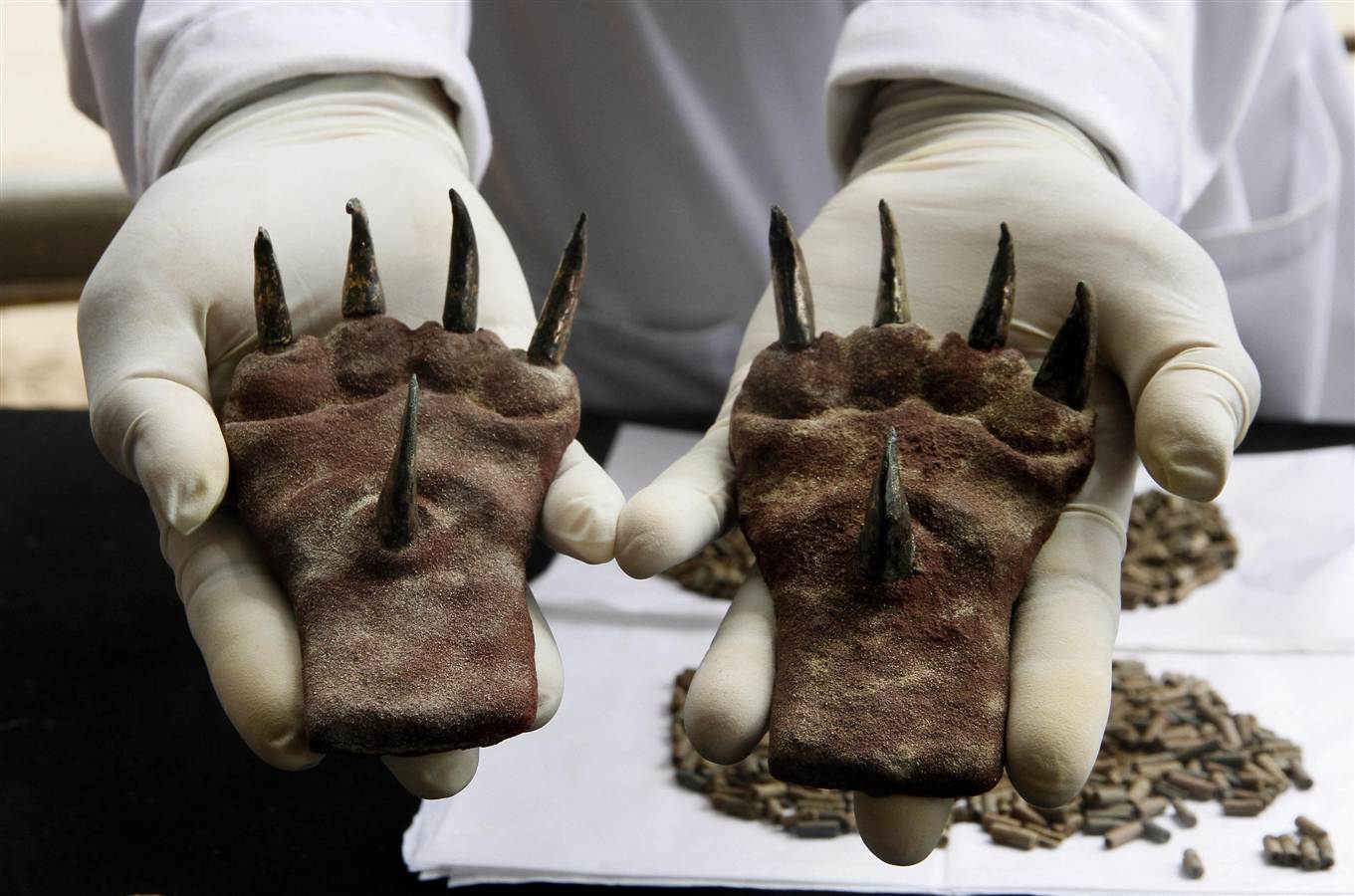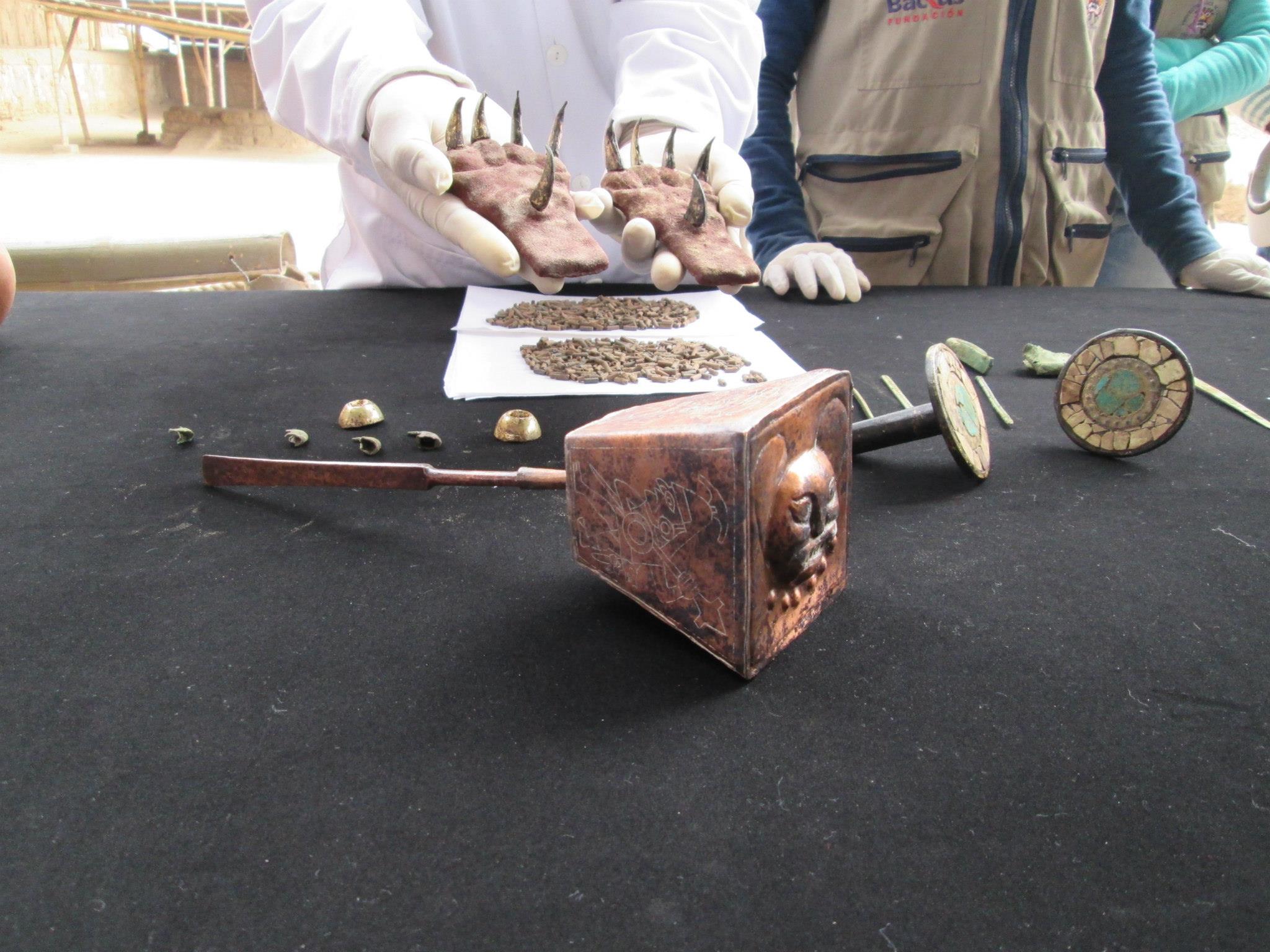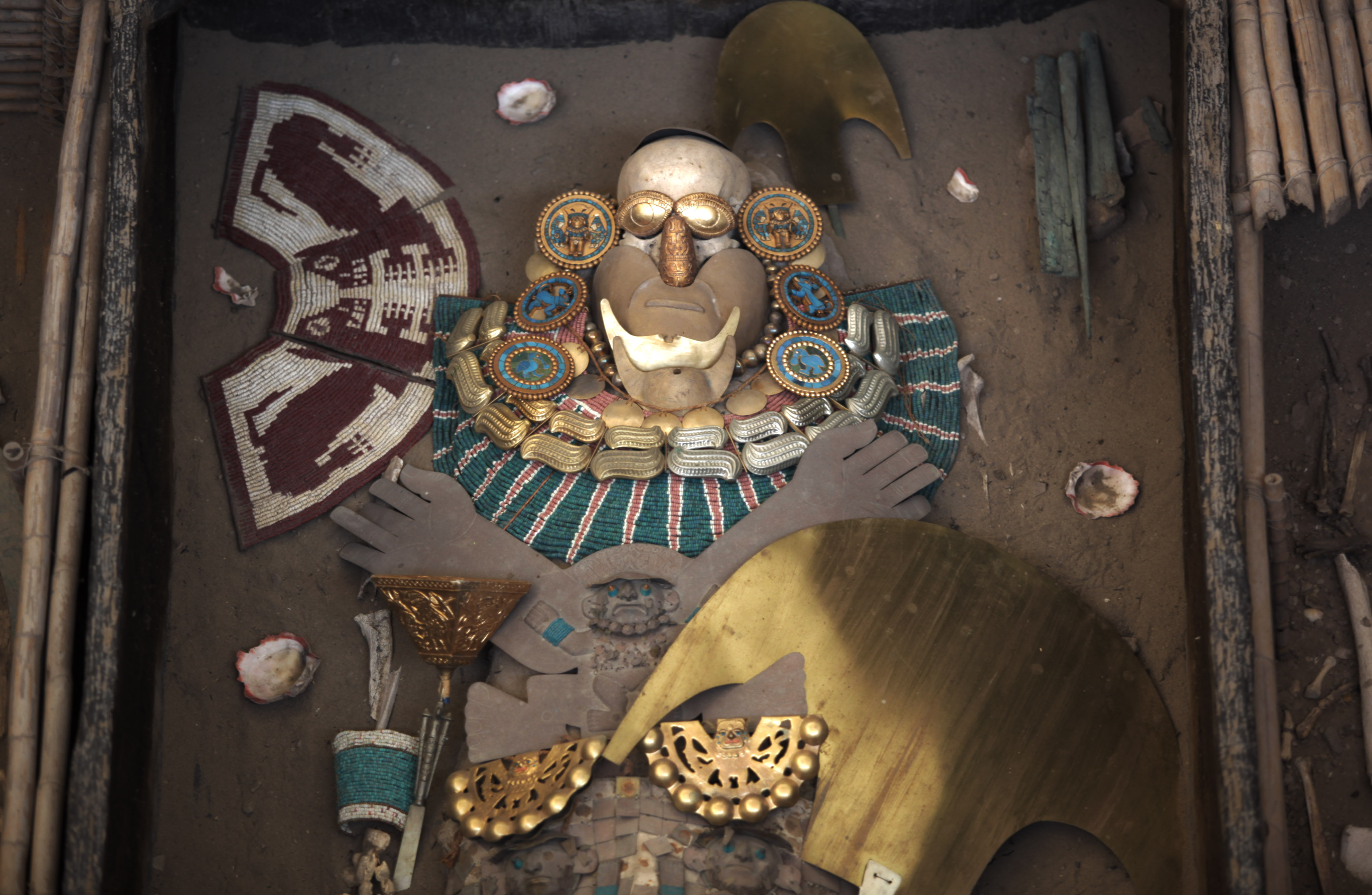It looks like you're using an Ad Blocker.
Please white-list or disable AboveTopSecret.com in your ad-blocking tool.
Thank you.
Some features of ATS will be disabled while you continue to use an ad-blocker.
9
share:
Well not quite, but still a very cool find!

Excerpts and Image source - NBC News
I don't remember ever hearing about a similar find. As a side note, I find it very interesting that this pre-Incan culture would view the scepter as a symbol of power. Scepters/Sceptres/Rods/Staffs have been a significant symbol of power in many cultures for thousands of years in Northern Africa, Europe and the Middle East. I wonder if this symbolism dates back possibly tens of thousands of years and shares a common origin?
EDIT:
I found an image with more of the artifacts that were found in the tomb (below) as well as some more detailed information at The History Blog. The scepter can be seen below along with what I believe are two eye coverings, many many beads and some very serious (ear) plugs.

link to larger image
EDIT 2:
The below image is actually Lord of Sipán, from a Moche tomb unearthed in 1987. My apologies!

link to larger image at source

Archaeologists in Peru say they have unearthed the previously unknown tomb of a nobleman from a pre-Inca civilization known as the Moche. The tomb contained the remains of an adult male, plus artifacts indicating the man's elite status, according to the Peruvian newspaper El Comercio.
Among the most intriguing artifacts are ornamental metal pieces fashioned to look like feline paws with claws. The paws may have been part of a ritual costume used in ceremonial combat, El Comercio reported. The loser would be sacrificed, while the winner would get the costume.
Trujillo, displayed the pieces as well as a copper scepter, bronze earrings, a mask and ceremonial ceramics on Thursday. "The scepter signifies power; the earrings, status; and the ceramic piece is typical of an elite personage," Uceda told El Comercio.
He said the tomb and its contents, which are thought to be 1,500 years old, could shed new light on the Moche culture, an agricultural and artistic society that collapsed around the year 800.
Excerpts and Image source - NBC News
I don't remember ever hearing about a similar find. As a side note, I find it very interesting that this pre-Incan culture would view the scepter as a symbol of power. Scepters/Sceptres/Rods/Staffs have been a significant symbol of power in many cultures for thousands of years in Northern Africa, Europe and the Middle East. I wonder if this symbolism dates back possibly tens of thousands of years and shares a common origin?
EDIT:
I found an image with more of the artifacts that were found in the tomb (below) as well as some more detailed information at The History Blog. The scepter can be seen below along with what I believe are two eye coverings, many many beads and some very serious (ear) plugs.

link to larger image
EDIT 2:
The below image is actually Lord of Sipán, from a Moche tomb unearthed in 1987. My apologies!

link to larger image at source
edit
on 2014-7-14 by theantediluvian because: (no reason given)
edit on 2014-7-14 by theantediluvian because: (no reason given)
extra DIV That mask is awesome!! Somebody oughta make a meme out of it.
originally posted by: Snarl
That mask is awesome!! Somebody oughta make a meme out of it.
It's definitely not as fierce as I would have expected for a costume won through mortal combat. He kinda looks nonplussed about the whole affair, as though he'd been peacefully resting until a team of very ill-mannered archaeologists disturbed him.
a reply to: theantediluvian
It may have been related to a club which may have been one of the first weapons mankind made, and by its invention greatly increased his 'power' over animals and other humans.
Interesting thread, thanks for posting this
I find it very interesting that this pre-Incan culture would view the scepter as a symbol of power. Scepters/Sceptres/Rods/Staffs have been a significant symbol of power in many cultures for thousands of years in Northern Africa, Europe and the Middle East. I wonder if this symbolism dates back possibly tens of thousands of years and shares a common origin?
It may have been related to a club which may have been one of the first weapons mankind made, and by its invention greatly increased his 'power' over animals and other humans.
Interesting thread, thanks for posting this
Way cool! Thanks for sharing.
a reply to: Hanslune
Aye, "flared and squared" clubs were certainly in-vogue in the Central and South Americas, i had a fascinating paper on them which i just looked for but it must have been saved on my old PC which i replaced a few months ago.. i cant remember for the life of me which peoples it mostly focussed on but it was possibly Caribbean. I'm totally gonna make one.
a reply to: Hanslune
Aye, "flared and squared" clubs were certainly in-vogue in the Central and South Americas, i had a fascinating paper on them which i just looked for but it must have been saved on my old PC which i replaced a few months ago.. i cant remember for the life of me which peoples it mostly focussed on but it was possibly Caribbean. I'm totally gonna make one.
Don't discount the role of phallic imagery and association with strength/virility in the scepter's case, either.
The ceremonial costume is pretty sweet, those claws look like they could do some damage. Makes me wonder if the winner received a ceremonial scratching post to keep them in good condition.
The ceremonial costume is pretty sweet, those claws look like they could do some damage. Makes me wonder if the winner received a ceremonial scratching post to keep them in good condition.
originally posted by: Hanslune
a reply to: theantediluvian
I find it very interesting that this pre-Incan culture would view the scepter as a symbol of power. Scepters/Sceptres/Rods/Staffs have been a significant symbol of power in many cultures for thousands of years in Northern Africa, Europe and the Middle East. I wonder if this symbolism dates back possibly tens of thousands of years and shares a common origin?
It may have been related to a club which may have been one of the first weapons mankind made, and by its invention greatly increased his 'power' over animals and other humans.
Interesting thread, thanks for posting this
That makes sense. I would guess a solid stick would be right there with the rock as the first weapons used by man. The stick being the archetype for clubs, bludgeons, maces, staffs, etc. What got me thinking is the use of the word scepter which typically implies a full-length staff or a wand (shortened staff) as opposed to a mace or club. The staff/scepter being a symbol of power, authority and even divinity (in the form of a wand) going back at least to Mesopotamia and prominent in ancient Greece and Egypt.
Don't discount the role of phallic imagery and association with strength/virility in the scepter's case, either.
Yep.
edit on 2014-7-14 by theantediluvian because: (no reason given)
new topics
-
Democrats Introduce Bill That Will Take Away Donald Trumps Secret Service Protection
2024 Elections: 14 minutes ago -
Planned Parenthood Targets Black Neighborhoods
Social Issues and Civil Unrest: 1 hours ago -
Who could it beeee now?
New World Order: 4 hours ago -
The Russian Vostok complex has been put into operation in Antarctica
Science & Technology: 4 hours ago -
Letitia James tells judge to Reject Trumps $175 Million Bond
2024 Elections: 5 hours ago -
Tucker Carlson UFOs are piloted by spiritual entities with bases under the ocean and the ground
Aliens and UFOs: 5 hours ago -
Hello from burritocat
Introductions: 6 hours ago -
An Apology From the Dunderbeck Sausage Company
Music: 9 hours ago -
Tucker on Joe Rogan talking Kona Blue and UFOs
Aliens and UFOs: 9 hours ago -
Remember These Attacks When President Trump 2.0 Retribution-Justice Commences.
2024 Elections: 10 hours ago
top topics
-
The Russian Vostok complex has been put into operation in Antarctica
Science & Technology: 4 hours ago, 11 flags -
Michigan school district cancels lesson on gender identity and pronouns after backlash
Education and Media: 14 hours ago, 11 flags -
Remember These Attacks When President Trump 2.0 Retribution-Justice Commences.
2024 Elections: 10 hours ago, 8 flags -
WF Killer Patents & Secret Science Vol. 1 | Free Energy & Anti-Gravity Cover-Ups
General Conspiracies: 12 hours ago, 8 flags -
Pentagon acknowledges secret UFO project, the Kona Blue program | Vargas Reports
Aliens and UFOs: 17 hours ago, 7 flags -
Letitia James tells judge to Reject Trumps $175 Million Bond
2024 Elections: 5 hours ago, 6 flags -
Boston Dynamics say Farewell to Atlas
Science & Technology: 17 hours ago, 6 flags -
Israel attacking Iran again.
Middle East Issues: 14 hours ago, 5 flags -
Who could it beeee now?
New World Order: 4 hours ago, 5 flags -
Hurt my hip; should I go see a Doctor
General Chit Chat: 13 hours ago, 3 flags
active topics
-
Who could it beeee now?
New World Order • 19 • : 19Bones79 -
The Russian Vostok complex has been put into operation in Antarctica
Science & Technology • 15 • : stonerwilliam -
Planned Parenthood Targets Black Neighborhoods
Social Issues and Civil Unrest • 12 • : SchrodingersRat -
Democrats Introduce Bill That Will Take Away Donald Trumps Secret Service Protection
2024 Elections • 2 • : FlyersFan -
Silent Moments --In Memory of Beloved Member TDDA
Short Stories • 51 • : Naftalin -
Remember These Attacks When President Trump 2.0 Retribution-Justice Commences.
2024 Elections • 27 • : Justoneman -
Israel attacking Iran again.
Middle East Issues • 53 • : Xtrozero -
Hello from burritocat
Introductions • 8 • : BernnieJGato -
911 emergency lines are DOWN across multiple states
Breaking Alternative News • 11 • : TheGoondockSaint -
George Knapp AMA on DI
Area 51 and other Facilities • 31 • : stonerwilliam
9
